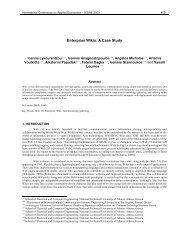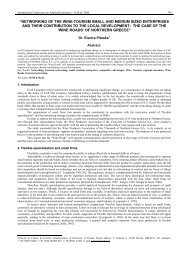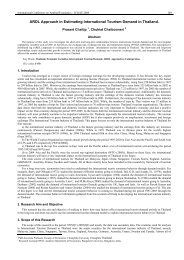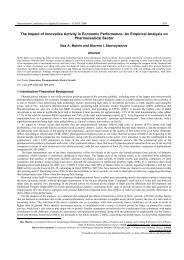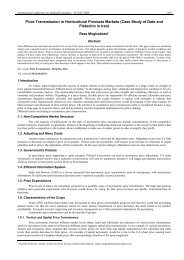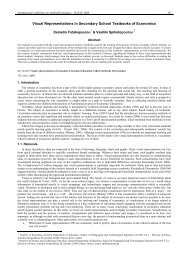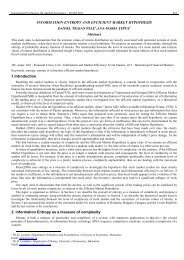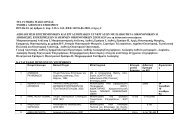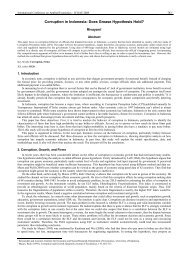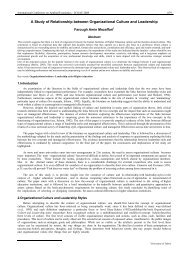Budget & Trade Deficit Sustainability: The Case of Cyprus
Budget & Trade Deficit Sustainability: The Case of Cyprus
Budget & Trade Deficit Sustainability: The Case of Cyprus
Create successful ePaper yourself
Turn your PDF publications into a flip-book with our unique Google optimized e-Paper software.
International Conference on Applied Economics – ICOAE 2009 13<br />
<strong>Budget</strong> & <strong>Trade</strong> <strong>Deficit</strong> <strong>Sustainability</strong>: <strong>The</strong> <strong>Case</strong> <strong>of</strong> <strong>Cyprus</strong><br />
Athanasios L. Athanasenas 1 , Constantinos Katrakilidis 2 , Panagiotis Pantelidis 3<br />
Abstract<br />
One <strong>of</strong> the most important open macroeconomics issues, during the current global economic turmoil and expanding recession, concerns the<br />
sustainability <strong>of</strong> persistent budget and trade deficits. <strong>The</strong>se deficits are most crucial due to severe debt servicing costs, faced by today‘s<br />
economies despite their development level. Here, we present time series evidence, theoretically consistent with the budget and trade deficit<br />
sustainability theory, using quarterly data over the period 1995 up to 2007. We focus on the <strong>Cyprus</strong> Economy; where, previous research on<br />
this issue has not been done, to the best <strong>of</strong> our knowledge. Our results confirm the fundamental sustainability <strong>of</strong> both deficits, for the<br />
specific time period involved.<br />
JEL: F32, F41, H62.<br />
Key Words: <strong>Budget</strong> and <strong>Trade</strong> <strong>Deficit</strong>s, <strong>Sustainability</strong>, ARDL - Cointegration.<br />
1. Introduction<br />
One <strong>of</strong> the hottest macroeconomic issues during the current economic turmoil concerns the sustainability <strong>of</strong><br />
persistent current account deficits due to severe debt servicing costs, faced by both industrial advanced economies and<br />
many developing countries as well. <strong>The</strong>se threatening economic characteristics <strong>of</strong> today‘s global depression reinforce the<br />
question on the ability <strong>of</strong> a country to service and repay its debt by avoiding default (Wickens and Uctum, 1993).<br />
Public deficits have created increased borrowing requirements for Governments worldwide. More particularly,<br />
developed economies turn, basically, to domestic borrowing, whereas developing ones turn to both domestic and foreign<br />
capital. In any case, though, high deficit levels eventually lead to an accumulation <strong>of</strong> debt, which forces a constant<br />
necessity for financial discipline and control over the public deficit (e.g. Hakkio and Rush, 1991; Haug, 1991).<br />
On the other hand, long-run persistent current account deficits tend to have certain harmful effects on domestic<br />
economy, such as increase in domestic interest rates relative to their foreign counterparts, so that an excessive accumulated<br />
external debt burden is imposed on future generations. Much empirical research on the US economy has been conducted<br />
verifying the aforementioned claims (e.g. Husted, 1992; Tanner and Liu, 1994; Liu and Tanner, 1995).<br />
It is well known that over the last decade, the <strong>Cyprus</strong> economy has experienced persistent current account<br />
deficits, partly due to its high dependence on imported oil and the large consecutive increases in imported oil prices, so that<br />
its current account deficit increased from 2.0% <strong>of</strong> GDP in 2003 to 5.9% in 2006. However, if foreign lenders believe that<br />
the borrowers will not be capable <strong>of</strong> reimbursing their loans, borrowing abroad will be denied (Milesi – Ferreti et al.,<br />
1996a, 1996b). Thus, it is quite reasonable to investigate the sustainability issue <strong>of</strong> the inter-temporal budget and trade<br />
deficits.<br />
Despite the significant growth <strong>of</strong> the international literature on the investigation <strong>of</strong> the dynamic characteristics <strong>of</strong><br />
the so called ―twin deficits‖ and their sustainability properties, to the best <strong>of</strong> our knowledge, there is lack <strong>of</strong> empirical<br />
evidence regarding the case <strong>of</strong> <strong>Cyprus</strong>. Accordingly, the objectives <strong>of</strong> this study are i) to test for the sustainability <strong>of</strong> the<br />
<strong>Cyprus</strong> budget and trade deficits, thus adding to the relevant literature and, ii) to differentiate from other empirical efforts<br />
by using a time series technique more suitable and efficient in cases <strong>of</strong> small data sets. Actually, the empirical analysis is<br />
carried over by means <strong>of</strong> the ARDL cointegration methodology proposed by Pesaran and Shin (1999).<br />
1 Assistant Pr<strong>of</strong>essor, Department <strong>of</strong> Business Administration, School <strong>of</strong> Administration and Economics, Institute <strong>of</strong> Technology and<br />
Education <strong>of</strong> Serres (A.T.E.I.S.), Terma Magnesias Str. 621-24, Serres, Greece. E-mail: athans@teiser.gr.<br />
2 Associate Pr<strong>of</strong>essor, Department <strong>of</strong> Economics, Aristotle University <strong>of</strong> <strong>The</strong>ssaloniki.<br />
Corresponding Address: P.O. Box 213, <strong>The</strong>ssaloniki 54006; Greece. E-mail: katrak@econ.auth.gr<br />
3 Assistant Pr<strong>of</strong>essor, Department <strong>of</strong> Business Administration, School <strong>of</strong> Administration and Economics, Institute <strong>of</strong> Technology and<br />
Education <strong>of</strong> Serres (A.T.E.I.S.), Terma Magnesias Str. 621-24, Serres, Greece. E-mail: pan@teiser.gr.
14 International Conference on Applied Ecomonics – ICOAE 2009<br />
<strong>The</strong> paper is divided into five consecutive sections. Namely, Section (2) describes briefly the deficits issue within<br />
the Cypriot Economy. Section (3), presents the theoretical foundation <strong>of</strong> the sustainability concept for both deficits<br />
considered. Section (4), next, briefly describes the fundamentals <strong>of</strong> the ARDL approach to cointegration, which is also<br />
analysed in Appendix I. Section (5) is focusing upon the data and empirical results; whereas, last section (6) provides a<br />
short summary and conclusions subject. Appendix II, presents all our econometric results, statistics and related graphs.<br />
2. A Brief Reference to the Cypriot <strong>Deficit</strong>s.<br />
Since 1990‘s, <strong>Cyprus</strong> has enjoyed a steady economic growth around 4% yearly, with low inflation and<br />
unemployment, along with a stable exchange rate. <strong>The</strong> fiscal account, however, has been persistently at a deficit since<br />
1970‘s, and during 1990‘s the Cypriot economy faces increasing fiscal deficits partly due to Custom‘s Union Agreement<br />
and the reduction <strong>of</strong> the revenues from customs duties, and wage increases. In fiscal years 1993 and 1994, deficit<br />
improvement is attributed to the VAT rate increase from 5% to 8%.<br />
Nevertheless, exogenous oil shocks along with partial loss <strong>of</strong> competitiveness in some sectors <strong>of</strong> the economy all<br />
reflect negatively upon the current account deficit. Thus, fiscal deficit and financing constitute a potentially major<br />
destabilizing factor in the domestic economy, thus exerting pressure on the trade account (See, especially, Spanos et al.,<br />
1997).<br />
Over the current decade, under the requirements <strong>of</strong> the Stability and Growth Pact and along the lines <strong>of</strong> the<br />
Maastricht convergence criteria, the fiscal deficit that peaked at 6.5% <strong>of</strong> GDP in 2003 has been reduced to 1.2% <strong>of</strong> GDP in<br />
2006. Accordingly, public debt, that exceeded 70% <strong>of</strong> GDP in 2004, declined to 65.2% in 2006.<br />
On the other hand, <strong>Cyprus</strong> is a small open economy, highly dependent on imported oil. As a consequence, the<br />
large consecutive increases in oil prices <strong>of</strong> the recent past have affected its current account deficit, which increased from<br />
2.0% <strong>of</strong> GDP in 2003 up to 5.9% in 2006. Moreover, the structural reforms set out in the National Lisbon Programe should<br />
be implemented in order to increase diversification <strong>of</strong> the economy into high value added activities, the promotion <strong>of</strong><br />
research and development, and the strengthening <strong>of</strong> the competitive environment.<br />
3. <strong>The</strong> Concept <strong>of</strong> <strong>Sustainability</strong>: Basic <strong>The</strong>oretical Issues<br />
3.1 <strong>Budget</strong> <strong>Deficit</strong> <strong>Sustainability</strong><br />
<strong>The</strong> more widely acceptable definition <strong>of</strong> sustainability is based on the concept <strong>of</strong> inter-temporal budget<br />
constraint, which states that the present value <strong>of</strong> debt, at the limit, tends to zero. Let us suppose then that the deficit is<br />
financed with government bonds maturing in one year. This means that in every time period, government faces the<br />
following national budget constraint:#<br />
Where:<br />
G (1 r ) B R B ,<br />
(1)<br />
t t t1 t t<br />
G equals public spending not including debt servicing costs; that is, public consumption plus transfer<br />
payments; r equals the real interest rate per period; B equals the accumulated debt, and R being the public<br />
receipts.<br />
Consecutive substitutions in (1) above, give the following relation for the inter-temporal budget<br />
constraint:<br />
s s<br />
1 1<br />
t (1 ti ) ( ts ts ) lim (1 ti ) ts .<br />
s<br />
s0 i1 i1<br />
(2)<br />
B r R G r B<br />
At this point, two hypotheses accrue: (a) real interest rate is stable, with average value r, and (b) the<br />
real supply <strong>of</strong> bonds has an annual rate <strong>of</strong> change that, on average, is no higher than the average interest rate<br />
r. Based on these two hypotheses we have:
International Conference on Applied Economics – ICOAE 2009 15<br />
s<br />
lim(1 r) B 0 . (3)<br />
s<br />
ts <strong>The</strong> above formula (3) essentially states that the present value <strong>of</strong> the debt tends to zero. Additionally, it<br />
states that the government does not have the option <strong>of</strong> continually creating deficits. However, Hamilton and<br />
Flavin (1986) claim that (2) and (3) before do not exclude the existence <strong>of</strong> a constant permanent fiscal deficit.<br />
As long as deficits are such that they push debt at a rate less than that <strong>of</strong> the interest rate, (3) will be satisfied.<br />
Alternatively, according to Hakkio and Rush (1991), sustainability <strong>of</strong> accumulated debt can be estimated<br />
using the following regression:<br />
R a G u , (4)<br />
t 1 1 t t<br />
Where:<br />
1 1,<br />
checking whether t<br />
(Quintos, 1995):<br />
R and t<br />
G form a co-integration relationship. It can be shown that<br />
• the deficit is sustainable, in the ―strict sense‖, if and only if the t<br />
I(1), are co-integrated and 1 1 ;<br />
0 1 1,<br />
• the deficit is sustainable, in the ―weak sense‖, if the t<br />
• the deficit is not sustainable if 1 0.<br />
R and t<br />
R and t<br />
G series, which are<br />
G series are co-integrable and<br />
<strong>Sustainability</strong> in the ―strict sense‖ (i.e. ―strong sustainability‖) means that the limitation <strong>of</strong> the budget is valid<br />
and, at the same time the un-prepaid debt B t is I(1). <strong>Sustainability</strong> in the ―weak sense‖ (i.e.: ―weak sustainability‖) means<br />
that the limitation is valid but the B t is magnified at a rate that is lower than the growth rate <strong>of</strong> the economy, which<br />
approaches the average real interest rate. Even if this latter situation is consistent with sustainability, it may have<br />
consequences which affect the government‘s ability to negotiate its debt and, for this reason it is the least desirable<br />
scenario. A deficit which is not sustainable is one where B t is stated as developing at a rate equal to or greater than the rate<br />
<strong>of</strong> growth <strong>of</strong> the economy, such that it contravenes the inter-temporal budget constraint.<br />
3.2 <strong>Trade</strong> <strong>Deficit</strong> <strong>Sustainability</strong><br />
Next, according to Hakkio and Rush (1991) and Husted (1992), an economy‘s external sector can be<br />
described by the following identity:<br />
M (1 i ) D X D ,<br />
(5)<br />
t t t1 t t<br />
Where:<br />
M t represents country‘s imports <strong>of</strong> goods and services, without ―sinking funds‖ (that is, interest plus<br />
debt) described by the second term (1 it) Dt1; X t describes the country‘s exports <strong>of</strong> goods and services,<br />
whereas D t is the country‘s external borrowing at time t.<br />
Hence, the inter-temporal foreign sector constraint becomes (Hakkio & Rush, 1991; Husted, 1992):<br />
<br />
D0 dt ( X t Mt ) lim dnDn , (6)<br />
t1<br />
n
16 International Conference on Applied Ecomonics – ICOAE 2009<br />
With d t being the future external surpluses discount coefficient. In (6) above, with the second term becoming<br />
zero, the external borrowing equals the present value <strong>of</strong> X M .<br />
t t<br />
Assuming an inter-national interest rate stationary at average price I, adding and subtracting from (5) iDt 1 ,<br />
we get:<br />
Where:<br />
<br />
t t t1 <br />
j1 t <br />
j0<br />
t j t j<br />
tj <br />
j<br />
t j<br />
(7)<br />
M i D X ( X E ) lim D ,<br />
E Mt ( it I) Dt 1,<br />
whereas the left part <strong>of</strong> (7) corresponds to the total expenses for imports and<br />
interest payments. Assuming non-stationary X and E time series at their levels, but stationary at firstdifferences,<br />
(7) above can be transformed as follows:<br />
t j<br />
Mt iDt 1 a Xt lim Dt j et<br />
,<br />
<br />
(8)<br />
j<br />
Subtracting X t from both sides <strong>of</strong> (8) and multiplying by (-1), the left side becomes:<br />
Assuming that:<br />
we get:<br />
Where:<br />
( Xt Mt it Dt 1)<br />
.<br />
t j<br />
lim D 0<br />
<br />
j<br />
tj ,<br />
X a MM<br />
e ,<br />
(9)<br />
t t t<br />
MMt Mt it Dt 1<br />
represents import expenses plus interest payments. Thus, we fundamentally<br />
question whether imports and exports time series become cointegrated. If long-run cointegration is justified,<br />
then we claim that external sector debt (or, in fact, the trade deficit) becomes stable; that is, sustainable<br />
(Hakkio and Rush, 1991).<br />
In (9) above, following Hakkio and Rush (1991), must equal 1 and e t must be stationary for an<br />
economy to achieve sustainability <strong>of</strong> its external sector debt (i.e. trade deficit sustainability). Nevertheless,<br />
sustainability holds even if gets less than unity, but then the un-prepaid net present value <strong>of</strong> the external<br />
debt faces unbounded increase.<br />
4. Methodology and Model Structure<br />
<strong>The</strong> autoregressive distributed lag (ARDL) approach to cointegration applied in this paper is a relatively new<br />
technique for detecting possible long-run relationships among economic variables. <strong>The</strong> ARDL approach is a more efficient<br />
technique for determining cointegrating relationships in small samples. An additional advantage <strong>of</strong> the ARDL approach is<br />
that it can be applied irrespective <strong>of</strong> the regressors‘ order <strong>of</strong> integration (Pesaran and Shin (1999)); that is, it can be applied<br />
regardless <strong>of</strong> the stationary properties <strong>of</strong> the variables in the sample, thus allowing for statistical inferences on long-run<br />
estimates which are not possible under alternative cointegration techniques. Hence, we are not concerned whether the<br />
applied series are I(0) or I(1). <strong>The</strong> general form <strong>of</strong> the ARDL model (Pesaran and Shin, 1999) is defined as:
International Conference on Applied Economics – ICOAE 2009 17<br />
Where:<br />
, (10)<br />
'<br />
( L) yt 0 1wt( L) xit ut<br />
<br />
i<br />
( L) 1 L,<br />
<br />
i1<br />
<br />
and<br />
<br />
( L) jL<br />
with (L) being the lag operator and ( w t ) being the vector <strong>of</strong> deterministic variables such as the intercept,<br />
seasonal dummies, time trends or any exogenous variables (with fixed lags). This approach follows three steps;<br />
namely, step one is the establishment <strong>of</strong> the long-run relationship between the variables (unrestricted error<br />
correction mechanism regression). Step two is the estimation <strong>of</strong> the ARDL form <strong>of</strong> equation (1), where the<br />
optimal lag length is chosen according to the Akaike Information Criterion (AIC) or the Schwarz Bayesian<br />
Criterion (SBC). Step three refers to the estimation <strong>of</strong> error correction equation, using the differences <strong>of</strong> the<br />
variables and the lagged long-run solution, where the speed <strong>of</strong> adjustment <strong>of</strong> the equilibrium is determined.<br />
5. Data and Empirical Results<br />
Our empirical analysis engages quarterly data <strong>of</strong> the <strong>Cyprus</strong> economy, taken from the IFS (IMF) database and the<br />
period covered runs from 1995, 1 st quarter to 2007, 3 rd quarter. For the case <strong>of</strong> the budget deficit sustainability, the involved<br />
variables are the log <strong>of</strong> the nominal government spending (LGS) and the log <strong>of</strong> the nominal government revenues (LRS).<br />
For the case <strong>of</strong> the trade deficit sustainability, we use the log <strong>of</strong> the country‘s exports (LXS) and, the log <strong>of</strong> the country‘s<br />
imports (LMS), accordingly. All four variables are de-seasonalized.<br />
Instead <strong>of</strong> employing the traditional methodology proposed by Johansen (1988 and 1989), which requires nonstationary<br />
variables <strong>of</strong> integration order I(1), we apply the ARDL Cointegration method proposed by Pesaran (1992).<br />
Actually, the ARDL method has the advantage to avoid the problem <strong>of</strong> pre-testing for the order <strong>of</strong> integration <strong>of</strong> the<br />
individual series; besides, ARDL is a single equation estimation technique and requires the estimation <strong>of</strong> a fairly smaller<br />
number <strong>of</strong> parameters compared to the Johansen‘s method. Consequently, ARDL proves to be more efficient when small<br />
data samples are available.<br />
As is usual in the empirical analysis, in the first step <strong>of</strong> the empirical analysis we examine the integration<br />
properties <strong>of</strong> the variables involved by means <strong>of</strong> the conventional Augmented Dickey-Fuller (ADF) test. It should be<br />
noted that statistical inference with non-stationary data might lead to invalid results. <strong>The</strong> results (Table 1),<br />
suggest that all variables are non-stationary when tested in log-level form, regardless <strong>of</strong> the existence <strong>of</strong> an<br />
intercept or both an intercept and a linear trend, in the testing equation. Furthermore, when the variables are<br />
considered in first-difference form, all <strong>of</strong> them exhibit stationary properties. Since the variables are integrated<br />
<strong>of</strong> order one, I(1), we proceed with testing for sustainability through the examination <strong>of</strong> the joint integration<br />
properties <strong>of</strong> the series by applying the ARDL cointegration methodology.<br />
5.1 <strong>Budget</strong> <strong>Deficit</strong> <strong>Sustainability</strong><br />
We start our analysis with the budget deficit sustainability case by testing for the existence <strong>of</strong> a possible long-run<br />
equilibrium relationship (cointegration) with long-run causality running from government spending (LGS) towards<br />
government revenues (LRS). In the first step, we estimate the unrestricted error correction (EC) model described below<br />
and, apply an F-test on the group <strong>of</strong> the lagged level variables. <strong>The</strong> specific form <strong>of</strong> the model follows.<br />
n n<br />
dLRS d f dLRS g dLGS LRS LGS e , (11),<br />
t 0 j t j j ( t) 1 t1 2 t1 1t<br />
j1 j1<br />
where, the parameter i ,( i 1,2), is the corresponding long-run multiplier, while the parameters fj, gj, are<br />
the short-run dynamic coefficients <strong>of</strong> model.<br />
<strong>The</strong> optimal lag structure <strong>of</strong> the model is chosen based on the Akaike Information Criterion (AIC), using a max<br />
lag length <strong>of</strong> two periods. <strong>The</strong> F-test on the group <strong>of</strong> the lagged level variables along with the critical value bounds are<br />
presented in Table (2). Actually, the reported F-value is found slightly lower from the upper critical value bound and hence<br />
the evidence is inconclusive. In such a case, we can proceed as if we had detected cointegration and justify our decision<br />
later, based on the estimated error correction term at the third step <strong>of</strong> the ARDL methodology as it is described in Section 4.<br />
Considering cointegration among the involved variables, we proceed with the estimation <strong>of</strong> the appropriate<br />
ARDL model. <strong>The</strong> optimal ARDL (2,0) specification has been chosen based on the AIC and is presented in Table (3). <strong>The</strong><br />
j1<br />
j<br />
,
18 International Conference on Applied Ecomonics – ICOAE 2009<br />
corresponding diagnostic tests validate the estimates, while the plots <strong>of</strong> the corresponding CUSUM and CUSUMSQ tests,<br />
based on the recursive residuals (Graph 1), identify long-run structural stability for the model‘s coefficients.<br />
<strong>The</strong> estimated long-run coefficients from the implied ARDL structure are reported in Table (4). <strong>The</strong> estimates<br />
reveal strong long-run causal effect (at a smaller than the 1% level <strong>of</strong> statistical significance) directed from government<br />
spending towards government revenues. Next, we apply a Wald‘s test to check whether 1, i.e. whether strong or<br />
weak sustainability holds. <strong>The</strong> Wald –test, reported in Table (5), suggests that the null hypothesis cannot be rejected (pvalue<br />
less than 10%) and consequently, we could consider that there is evidence is in favor <strong>of</strong> the existence <strong>of</strong> strong<br />
sustainability.<br />
Finally, Table (6) presents the estimates <strong>of</strong> the respective Error Correction (EC) specification. <strong>The</strong> existence <strong>of</strong> a<br />
long-run causal relationship among the examined variables is now clearly confirmed and our decision to proceed despite<br />
the inconclusive outcome <strong>of</strong> the previously reported F-test is now indirectly justified. Actually, the coefficient <strong>of</strong> the lagged<br />
EC term is found statistically significant (the p-value <strong>of</strong> the applied t-test is smaller than the 1%) and has the correct sign<br />
suggesting that any deviation from the long-term equilibrium path is corrected by 39 percent per quarter.<br />
5.2 <strong>Trade</strong> <strong>Deficit</strong> <strong>Sustainability</strong><br />
Along the same lines, we proceed next on the evaluation <strong>of</strong> the trade deficit sustainability. Tables (7-<br />
11) apply here. Accordingly, we test for the existence <strong>of</strong> a possible long-run equilibrium relationship with<br />
long-run causality running from country‘s imports (LMS) towards country‘s exports (LXS). In the first step<br />
here, we estimate the unrestricted error correction (EC) model described below and, apply an F-test on the<br />
group <strong>of</strong> the lagged level variables. <strong>The</strong> specific form <strong>of</strong> the model follows.<br />
n n<br />
dLXS a bdLXS c dLMS LXS LMS e , (12),<br />
( t) 0 j t j j ( t) 1 t1 2 t1 1t<br />
j1 j1<br />
where, the parameter i ,( i 1,2), is the corresponding long-run multiplier, while the parameters bj, cj, are<br />
the short-run dynamic coefficients <strong>of</strong> the model.<br />
<strong>The</strong> optimal lag structure <strong>of</strong> the model is chosen based on the Akaike Information Criterion (AIC), using a max<br />
lag length <strong>of</strong> four periods. <strong>The</strong> F-test on the group <strong>of</strong> the lagged level variables along with the critical value bounds are<br />
reported in Table (7). <strong>The</strong> evidence is in favor <strong>of</strong> the existence <strong>of</strong> a long-run equilibrium relationship with long-run<br />
causality running from LMS towards LXS.<br />
Having detected cointegration among the involved variables, we proceed with the estimation <strong>of</strong> the appropriate<br />
ARDL model. <strong>The</strong> optimal ARDL (4,0) specification has been chosen based on the AIC and is presented in Table (8). <strong>The</strong><br />
corresponding diagnostic tests validate the estimates, while the plots <strong>of</strong> the corresponding CUSUM and CUSUMSQ tests,<br />
based on the recursive residuals (Graph 2), identify long-run structural stability for the model‘s coefficients.<br />
<strong>The</strong> estimated long-run coefficients from the implied ARDL structure are reported in Table (9). <strong>The</strong> estimates<br />
reveal strong long-run causal effect (at a smaller than the 1% level <strong>of</strong> statistical significance), directed from country‘s<br />
imports towards country‘s exports. Next, we apply a Wald‘s test to check whether 1,<br />
i.e. whether strong or weak<br />
sustainability holds. <strong>The</strong> Wald-test, reported in Table (10), suggests that the null hypothesis cannot be rejected and<br />
consequently the evidence is in favor <strong>of</strong> the existence <strong>of</strong> strong sustainability.<br />
Finally, Table (11) presents the estimates <strong>of</strong> the respective Error Correction (EC) specification. <strong>The</strong> existence <strong>of</strong> a<br />
long-run causal relationship among the examined variables is confirmed once again, since the coefficient <strong>of</strong> the lagged EC<br />
term is found statistically significant (the p-value <strong>of</strong> the applied t-test is smaller than the 1%) and has the correct sign<br />
suggesting that any deviation from the long-term equilibrium path is corrected by 75 percent per quarter.<br />
6. Summary and Conclusive Remarks<br />
Summarizing our work, we restate that using quarterly data over the 1995-2007 period for the <strong>Cyprus</strong> economy,<br />
our analysis attempts to investigate both the budget and trade deficit (known as ―twin deficits‖) for sustainability using the<br />
ARDL approach to Cointegration.<br />
Our conclusions provide substantial statistical evidence that over the examined time span and before the current<br />
explosion <strong>of</strong> the global economic recession, the Cypriot economy shows clearly that both budget and trade deficit<br />
sustainability holds. Nevertheless, <strong>Cyprus</strong> accession to the EU along with its full participation to the eurozone financial
International Conference on Applied Economics – ICOAE 2009 19<br />
markets, and definitely the accelerating international recession, all demand much further econometric analyses to verify (or,<br />
transform) the aforementioned results.<br />
It is well known that the term ―twin deficits‖ started to worry economists in the early 80‘s in US, during the<br />
Reagan administration, when both budget and trade deficits soared dangerously. It is standard macroeconomics, however,<br />
that budget deficits lead to trade deficits only if budget deficits are indeed larger than net private (domestic) savings.<br />
Actually, there is an ongoing debate regarding the existence <strong>of</strong> a possible causal link between budget and trade deficits,<br />
such that the issue itself remains an open research question.<br />
Finally, a serious economic challenge for the Cypriot economy is the aging related public expenditure that<br />
threatens the long-run sustainability <strong>of</strong> public finance. Hence, increasing productivity, maintaining wages at competitive<br />
levels and promoting disciplined fiscal policies can restrain current account deficits.
20 International Conference on Applied Ecomonics – ICOAE 2009<br />
References<br />
Hakkio, C. (1995), ‗<strong>The</strong> US current account: <strong>The</strong> outer deficit‘, Federal Reserve Bank <strong>of</strong> Kansas City, Economic Review,<br />
80: 11-24.<br />
Hakkio, C. – Rush, M. (1991), ‗Is the budget deficit too large?‘, Economic inquiry, 29: 429-45.<br />
Haug, A. (1995), ‗Has Federal budget policy changed in recent years?, Economic Inquiry, 33: 104-18.<br />
Haug, A. (1991), ‗Cointegration and government borrowing constraints: evidence from the US‘, Journal <strong>of</strong> Business and<br />
Economic Statistics, 9: 97-101.<br />
Husted, S. (1992), ‗<strong>The</strong> emerging current account deficit in 1980‘s: cointegration analysis ,‘ <strong>The</strong> Review <strong>of</strong> Economics and<br />
Statistics, 74: 159-66.<br />
Johansen, S. (1988), ‗Statistical analysis <strong>of</strong> cointegration vectors‘, Journal <strong>of</strong> Economic Dynamics and Control, 12: 213-<br />
254.<br />
Johansen, S. – Juselius, C. (1990), ‗Maximum likelihood estimation and inference on cointegration with applications to the<br />
demand for money‘, Oxford Bulletin <strong>of</strong> Economics and Statistics, 52: 169-210.<br />
Liu, P. – Tanner, E. (1995), ‗Inter-temporal solvency and breaks in the US deficit process : a maximum-likelihood<br />
cointegration approach‘, Applied Economics Letters, 2: 231-5.<br />
Milesi-Ferretti, G. M. – Rasin, A. (1996a), ‗<strong>Sustainability</strong> <strong>of</strong> persistent current account deficits‘, NBER Working Paper,<br />
No. 5467.<br />
Milesi-Ferretti, G. M. – Rasin, A. (1996b), ‗Current account sustainability: selected East Asian and Latin American<br />
experiences,‘ NBER Working Paper, No. 5791.<br />
Pesaran, H., Shin, Y. (1999). ―An Autoregressive Distributed Lag Modeling Approach to Cointegration Analysis‖. In S.<br />
Strom (Ed.), Econometrics and Economic <strong>The</strong>ory in the 20th Century: <strong>The</strong> Ragnar Frisch Centennial Symposium.<br />
Cambridge Un. Press, Cambridge.<br />
Spanos, A. – Andreou, E. – Syrichas, G. (1997), A Var model for the monetary sector <strong>of</strong> the <strong>Cyprus</strong> economy, University<br />
<strong>of</strong> <strong>Cyprus</strong> & Central bank <strong>of</strong> <strong>Cyprus</strong>, Nicolaou, Nicosia, <strong>Cyprus</strong>.<br />
Tanner, E. – Liu, P. (1994), ‗Is the budget deficit too large?: some further evidence,‘ Economic Inquiry, 33: 511-18.<br />
Wickens, M. R. – Uctum, M. (1993), ‗<strong>The</strong> sustainability <strong>of</strong> current account deficits: a test <strong>of</strong> the US inter-temporal budget<br />
constraint,‘ Journal <strong>of</strong> Economic Dynamics and Control, 17: 423-44.
International Conference on Applied Economics – ICOAE 2009 21<br />
Appendix I<br />
ARDL Method: A brief <strong>The</strong>oretical Description<br />
<strong>The</strong> augmented autoregressive distributed lag model ARDL(p, q1, q2,,qk) is given by<br />
k<br />
( L,<br />
p)<br />
yt<br />
i ( L,<br />
qi<br />
) xit<br />
δ w<br />
t u t ,<br />
i1<br />
(A1)<br />
2<br />
p<br />
where ( L,<br />
p)<br />
1<br />
1L<br />
2L<br />
<br />
pL<br />
, (A2)<br />
( L,<br />
q ) L <br />
L , i=1,2,,k<br />
i<br />
i<br />
i0<br />
i1<br />
iqi<br />
qi<br />
(A3)<br />
wt is a s1 vector <strong>of</strong> deterministic variables (intercept, dummies, trend, exogenous variables with fixed lags) and<br />
r<br />
L is a lag operator defined as L yr<br />
yir<br />
.<br />
At the first step the procedure estimates a total <strong>of</strong> (m+1) k+1 different ARDL models, by means <strong>of</strong> the OLS<br />
method, for all possible values <strong>of</strong> p( p=0,1,…,m), q( q=0,1,…,m) and i( i=1,…,k). <strong>The</strong> maximum lag length can be<br />
determined by the researcher though the frequency <strong>of</strong> the data is crucial. <strong>The</strong> appropriate ARDL specification can be then<br />
chosen by means <strong>of</strong> alternative criteria such as the Akaike Information Criterion (AIC), the Schwarz Bayesian Criterion<br />
(SBC), the Hannan and Quinn (HQC), the R 2 and others.<br />
<strong>The</strong> long run coefficients for the response <strong>of</strong> yt to a unit change <strong>of</strong> xit are estimated by (Pesaran et al,<br />
1997, pp. 393-394):<br />
ˆ<br />
<br />
ˆ ˆ ˆ<br />
ˆ<br />
i ( 1,<br />
qˆ i ) i0<br />
i1<br />
<br />
iqˆ<br />
i<br />
<br />
ˆ<br />
( 1,<br />
pˆ ) 1<br />
ˆ<br />
ˆ<br />
<br />
ˆ<br />
i<br />
, i=1,2,,k<br />
1 2 pˆ<br />
(A4)<br />
where pˆ and qˆ i , i=1,2,,k are the selected values <strong>of</strong> p and qi. <strong>The</strong> long run coefficients associated with the<br />
deterministic and exogenous variables with fixed lags are estimated by<br />
δˆ<br />
( pˆ , qˆ , qˆ , ,<br />
qˆ<br />
)<br />
1 2 k<br />
ψ ˆ <br />
, (A5)<br />
1<br />
ˆ<br />
1 ˆ<br />
2 <br />
ˆ<br />
pˆ<br />
ˆ<br />
where ( , 1,<br />
2,<br />
, k ) <br />
δ denotes the OLS estimates <strong>of</strong> δ in (A1) for the selected ARDL specification.<br />
<strong>The</strong> ECM representation associated with the implied ARDL model can be obtained by writing (A1) in terms <strong>of</strong><br />
the lagged levels and the first differences <strong>of</strong> yt, x1t,….,xst and wt. Based on (A4) and (A5) the error correction term ECt is defined by<br />
k<br />
EC t y ˆ t ix<br />
it ψ ˆ w<br />
t .<br />
i1<br />
(A6)<br />
pˆ<br />
qˆ<br />
qˆ<br />
qˆ
22 International Conference on Applied Ecomonics – ICOAE 2009<br />
Appendix II<br />
<strong>Budget</strong> <strong>Deficit</strong> <strong>Sustainability</strong><br />
Table 1: Unit-Root Tests for the Variables<br />
Table 1: Augmented Dickey-Fuller (ADF) Unit Root Tests<br />
Variables<br />
Levels<br />
Without Trend With Trend<br />
LRS (2) 0.720 -2.784<br />
LGS (2) 0.484 -1.859<br />
LXS (2) -0.826 -2.980<br />
LMS (2) -0.647 -2.313<br />
Critical<br />
Values at 5%<br />
Variables<br />
-2.293 -3.511<br />
First Differences<br />
Without Trend With Trend<br />
DLRS (1) -6.939 -7.192<br />
DLGS (1) -7.616 -7.642<br />
DLXS (1) -5.412 -5.330<br />
DLMS (1) -7.025 -6.913<br />
Critical<br />
Values at 5%<br />
-2.928 -3.514<br />
Notes:<br />
1) <strong>The</strong> number <strong>of</strong> lags (indicating in the parentheses in the first column), used for the calculation <strong>of</strong> the ADF<br />
statistics, is based on the Schwarz Bayesian Criterion (SBC) provided by Micr<strong>of</strong>it.
International Conference on Applied Economics – ICOAE 2009 23<br />
Dependent<br />
Variable<br />
Table 2: Testing the Existence <strong>of</strong> a Long Run Relationship<br />
K AIC<br />
Lags<br />
F(LRS/ LGS) 1 1 F(2, 36)=<br />
4.551[.016]<br />
Table 3: Autoregressive Distributed Lag Estimates<br />
F-Statistic Intercept Trend Bounds<br />
Testing<br />
(at 90%)<br />
Yes No Lower:<br />
4.042<br />
Upper:<br />
4.788<br />
Autoregressive Distributed Lag Estimates<br />
ARDL(2,0) selected based on Akaike Information Criterion<br />
*******************************************************************************<br />
Dependent variable is LRS<br />
45 observations used for estimation from 1996Q1 to 2007Q1<br />
*******************************************************************************<br />
Regressor Coefficient Standard Error T-Ratio[Prob]<br />
LRS(-1) .12671 .12675 .99966[.323]<br />
LRS(-2) .47635 .12766 3.7313[.001]<br />
LGS .49314 .14582 3.3819[.002]<br />
C .016396 .013347 1.2284[.226]<br />
*******************************************************************************<br />
R-Squared .92828 R-Bar-Squared .92303<br />
S.E. <strong>of</strong> Regression .083217 F-stat. F( 3, 41) 176.8796[.000]<br />
Mean <strong>of</strong> Dependent Variable .026143 S.D. <strong>of</strong> Dependent Variable .29995<br />
Residual Sum <strong>of</strong> Squares .28393 Equation Log-likelihood 50.1262<br />
Akaike Info. Criterion 46.1262 Schwarz Bayesian Criterion 42.5128<br />
DW-statistic 1.9742<br />
*******************************************************************************<br />
Diagnostic Tests<br />
*******************************************************************************<br />
* Test Statistics * LM Version * F Version *<br />
*******************************************************************************<br />
* A:Serial Correlation CHSQ( 4)= 2.7425[.602] F( 4, 37)= .60031[.665]<br />
Outcome<br />
* B:Functional Form CHSQ( 1)= .088206[.766] F( 1, 40)= .078559[.781]<br />
* C:Normality CHSQ( 2)= .99541[.608] Not applicable<br />
* D:Heteroscedasticity CHSQ( 1)= .14159[.707] F( 1, 43)= .13573[.714]<br />
*******************************************************************************<br />
No clear<br />
evidence
24 International Conference on Applied Ecomonics – ICOAE 2009<br />
Table 4: Estimated Long Run Coefficients using the ARDL Approach<br />
Estimated Long Run Coefficients using the ARDL Approach<br />
ARDL(2,0) selected based on Akaike Information Criterion<br />
*******************************************************************************<br />
Dependent variable is LRS<br />
45 observations used for estimation from 1996Q1 to 2007Q1<br />
*******************************************************************************<br />
Regressor Coefficient Standard Error<br />
T-Ratio[Prob]<br />
LGS 1.2423 .14068<br />
8.8311[.000]<br />
C .041305 .040150<br />
1.0288[.310]<br />
*******************************************************************************<br />
Table 5: Wald test <strong>of</strong> restriction(s) imposed on parameters<br />
Based on long run ARDL regression <strong>of</strong> LRS on:<br />
LGS C<br />
45 observations used for estimation from 1996Q1 to 2007Q1<br />
*******************************************************************************<br />
Coefficients A1 to A2 are assigned to the above regressors respectively.<br />
List <strong>of</strong> restriction(s) for the Wald test:<br />
a1=1;<br />
*******************************************************************************<br />
Wald Statistic CHSQ( 1)= 2.9677[.085]<br />
*******************************************************************************<br />
Table 6: Error Correction Representation for the Selected ARDL Model<br />
Error Correction Representation for the Selected ARDL Model<br />
ARDL(2,0) selected based on Akaike Information Criterion<br />
*******************************************************************************<br />
Dependent variable is dLRS<br />
45 observations used for estimation from 1996Q1 to 2007Q1<br />
*******************************************************************************<br />
Regressor Coefficient Standard Error T-Ratio[Prob]<br />
dLRS1 -.47635 .12766 -3.7313[.001]<br />
dLGS .49314 .14582 3.3819[.002]<br />
dC .016396 .013347 1.2284[.226]<br />
ecm(-1) -.39694 .13023 -3.0480[.004]<br />
*******************************************************************************<br />
ecm = LRS -1.2423*LGS -.041305*C<br />
*******************************************************************************<br />
R-Squared .54772 R-Bar-Squared .51462<br />
S.E. <strong>of</strong> Regression .083217 F-stat. F( 3, 41) 16.5505[.000]<br />
Mean <strong>of</strong> Dependent Variable .020725 S.D. <strong>of</strong> Dependent Variable .11945<br />
Residual Sum <strong>of</strong> Squares .28393 Equation Log-likelihood 50.1262<br />
Akaike Info. Criterion 46.1262 Schwarz Bayesian Criterion 42.5128<br />
DW-statistic 1.9742<br />
*******************************************************************************
International Conference on Applied Economics – ICOAE 2009 25<br />
Plot <strong>of</strong> Cumulative Sum <strong>of</strong> Recursive<br />
Residuals<br />
<strong>The</strong> straight lines represent critical bounds at 5% significance level<br />
Graph 1<br />
20<br />
15<br />
10<br />
5<br />
0<br />
-5<br />
-10<br />
-15<br />
-20<br />
1996Q1 1998Q3 2001Q1 2003Q3 2006Q1 2007Q1<br />
1.5<br />
1.0<br />
0.5<br />
0.0<br />
Plot <strong>of</strong> Cumulative Sum <strong>of</strong> Squares <strong>of</strong><br />
Recursive Residuals<br />
-0.5<br />
1996Q1 1998Q3 2001Q1 2003Q3 2006Q1 2007Q1<br />
<strong>The</strong> straight lines represent critical bounds at 5% significance level
26 International Conference on Applied Ecomonics – ICOAE 2009<br />
Dependent<br />
Variable<br />
F(LXS/<br />
LMS)<br />
K AIC<br />
Lags<br />
<strong>Trade</strong> <strong>Deficit</strong> <strong>Sustainability</strong><br />
Table 7: Testing the Existence <strong>of</strong> a Long Run Relationship<br />
1 1 F(2, 36)=<br />
5.321[.009]<br />
Table 8: Autoregressive Distributed Lag Estimates<br />
F-Statistic Intercept Trend Bounds<br />
Testing<br />
(at 90%)<br />
Yes No Lower:<br />
4.042<br />
Upper:<br />
4.788<br />
Autoregressive Distributed Lag Estimates<br />
ARDL(4,0) selected based on Akaike Information Criterion<br />
*******************************************************************************<br />
Dependent variable is LXS<br />
45 observations used for estimation from 1996Q1 to 2007Q1<br />
*******************************************************************************<br />
Regressor Coefficient Standard Error T-Ratio[Prob]<br />
LXS(-1) .36845 .12334 2.9872[.005]<br />
LXS(-2) .014055 .15263 .092085[.927]<br />
LXS(-3) -.60421 .15433 -3.9152[.000]<br />
LXS(-4) .46622 .12585 3.7046[.001]<br />
LMS .71920 .14612 4.9219[.000]<br />
C .0085695 .0098536 .86968[.390]<br />
*******************************************************************************<br />
R-Squared .94796 R-Bar-Squared .94129<br />
S.E. <strong>of</strong> Regression .050226 F-stat. F( 5, 39) 142.0983[.000]<br />
Mean <strong>of</strong> Dependent Variable .032191 S.D. <strong>of</strong> Dependent Variable .20729<br />
Residual Sum <strong>of</strong> Squares .098383 Equation Log-likelihood 73.9727<br />
Akaike Info. Criterion 67.9727 Schwarz Bayesian Criterion 62.5528<br />
DW-statistic 1.6540<br />
*******************************************************************************<br />
Diagnostic Tests<br />
*******************************************************************************<br />
* Test Statistics * LM Version * F Version *<br />
*******************************************************************************<br />
* A:Serial Correlation CHSQ( 4)= 4.9696[.290] F( 4, 35)= 1.0863[.378]<br />
* B:Functional Form CHSQ( 1)= 2.0788[.149] F( 1, 38)= 1.8404[.183]<br />
* C:Normality CHSQ( 2)= .88844[.641] Not applicable<br />
* D:Heteroscedasticity CHSQ( 1)= .29873[.585] F( 1, 43)= .28736[.595]<br />
*******************************************************************************<br />
Outcome<br />
Cointegration<br />
Exists
International Conference on Applied Economics – ICOAE 2009 27<br />
Table 9: Estimated Long Run Coefficients using the ARDL Approach<br />
Estimated Long Run Coefficients using the ARDL Approach<br />
ARDL(4,0) selected based on Akaike Information Criterion<br />
*******************************************************************************<br />
Dependent variable is LXS<br />
45 observations used for estimation from 1996Q1 to 2007Q1<br />
*******************************************************************************<br />
Regressor Coefficient Standard Error T-Ratio[Prob]<br />
LMS .95198 .048003 19.8316[.000]<br />
C .011343 .014390 .78823[.435]<br />
*******************************************************************************<br />
Table 10: Wald test <strong>of</strong> restriction(s) imposed on parameters<br />
Wald test <strong>of</strong> restriction(s) imposed on parameters<br />
*******************************************************************************<br />
Based on long run ARDL regression <strong>of</strong> LXS on:<br />
LMS C<br />
45 observations used for estimation from 1996Q1 to 2007Q1<br />
*******************************************************************************<br />
Coefficients A1 to A2 are assigned to the above regressors respectively.<br />
List <strong>of</strong> restriction(s) for the Wald test:<br />
a1=1;<br />
*******************************************************************************<br />
Wald Statistic CHSQ( 1)= 1.0009[.317]<br />
*******************************************************************************
28 International Conference on Applied Ecomonics – ICOAE 2009<br />
Table 11: Error Correction Representation for the Selected ARDL Model<br />
Error Correction Representation for the Selected ARDL Model<br />
ARDL(4,0) selected based on Akaike Information Criterion<br />
*******************************************************************************<br />
Dependent variable is dLXS<br />
45 observations used for estimation from 1996Q1 to 2007Q1<br />
*******************************************************************************<br />
Regressor Coefficient Standard Error T-Ratio[Prob]<br />
dLXS1 .12393 .14523 .85334[.399]<br />
dLXS2 .13799 .14251 .96828[.339]<br />
dLXS3 -.46622 .12585 -3.7046[.001]<br />
dLMS .71920 .14612 4.9219[.000]<br />
dC .0085695 .0098536 .86968[.390]<br />
ecm(-1) -.75549 .15218 -4.9644[.000]<br />
*******************************************************************************<br />
ecm = LXS -.95198*LMS -.011343*C<br />
*******************************************************************************<br />
R-Squared .64204 R-Bar-Squared .59615<br />
S.E. <strong>of</strong> Regression .050226 F-stat. F( 5, 39) 13.9903[.000]<br />
Mean <strong>of</strong> Dependent Variable .015500 S.D. <strong>of</strong> Dependent Variable .079035<br />
Residual Sum <strong>of</strong> Squares .098383 Equation Log-likelihood 73.9727<br />
Akaike Info. Criterion 67.9727 Schwarz Bayesian Criterion 62.5528<br />
DW-statistic 1.6540<br />
*******************************************************************************
International Conference on Applied Economics – ICOAE 2009 29<br />
Plot <strong>of</strong> Cumulative Sum <strong>of</strong> Recursive<br />
Residuals<br />
<strong>The</strong> straight lines represent critical bounds at 5% significance level<br />
Graph 2<br />
20<br />
15<br />
10<br />
5<br />
0<br />
-5<br />
-10<br />
-15<br />
-20<br />
1996Q1 1998Q3 2001Q1 2003Q3 2006Q1 2007Q1<br />
1.5<br />
1.0<br />
0.5<br />
0.0<br />
Plot <strong>of</strong> Cumulative Sum <strong>of</strong> Squares <strong>of</strong><br />
Recursive Residuals<br />
-0.5<br />
1996Q1 1998Q3 2001Q1 2003Q3 2006Q1 2007Q1<br />
<strong>The</strong> straight lines represent critical bounds at 5% significance level



